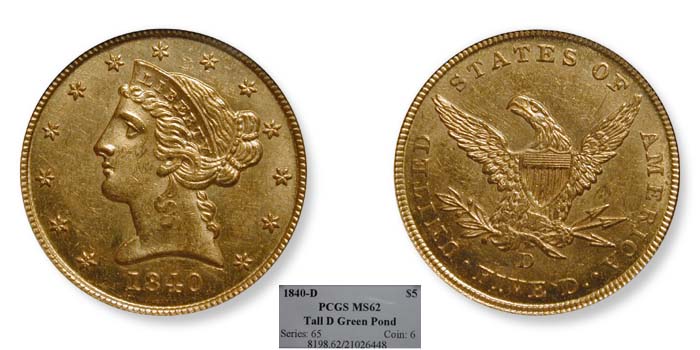1840-D $5 Tall D MS62 认证号21026448, PCGS号8198
专家评论
Doug Winter
In 1840, the design of the half eagle was modified. The new head has a neck that is less curved and positioned slightly differently than the head of 1839. In addition, the mintmark was placed on the reverse, where it would stay on all regular issue United States gold coins struck through 1933. Thus the 1840-D is an important issue as it is the first Dahlonega half eagle with the modified Liberty Head design.The 1840-D half eagle is most often seen in Very Fine to Extremely Fine grades. It is scarce in the lower About Uncirculated grades and rare in the upper range of this grade. It is extremely rare in Uncirculated.
STRIKE: The quality of strike is above average. Interestingly, 1840-D half eagles are often found with a much better strike than the other two branch mint half eagles struck in 1840 as both the Charlotte and New Orleans issues are not known for having good strikes. The central details on the obverse and the reverse are nearly always well-defined on the 1840-D half eagle. The borders are more likely to show weakness with some pieces having blurry denticles at the lower obverse and the lower reverse.
SURFACES: It is very hard to find an example which does not show conspicuous abrasions on the surfaces. In addition, a number show mint-made problems such as granular areas or laminations.
LUSTER: The luster on this date is very distinctive. It is frosty and has a pleasing soft appearance which does not resemble the texture seen on other Dahlonega half eagles struck during the first two years of production at this mint.
COLORATION: Uncleaned, original 1840-D half eagles are most often seen with deep green-gold or orange-green color. There are a few more original pieces known than for the 1839-D half eagle but most seen have been stripped of their color as a result of having been dipped or cleaned.
EYE APPEAL: This is a difficult issue to find with good eye appeal. Most 1840-D half eagles are heavily marked and most have their original surfaces stripped-off from repeated cleanings. Any example which has good eye appeal routinely sells for a strong premium over a typical coin.
DIE VARIETIES: According to Walter Breen, varieties of 1840-D half eagles are known which have a Broad Mill (as on half eagles struck from 1834 through 1839) and a Narrow Mill (the diameter seen on half eagles struck from 18941 through 1907). Breen believed that 4,437 1840-F half eagles with a diameter of 22.5 mm were coined on February 1840. The remainder were struck later in the year and had a diameter of 21.65 mm.
The comprehensive study yet undertaken on half eagle diameters was performed by Q. David Bowers on pages 265 and 266 of the October, 1987 Norweb Collection sale catalog. The 1840-D half eagle in the Norweb sale (Lot 801) had a diameter of 21.8 mm and was, this, designated as a Narrow Mill coin.
It is my belief that all 1840-D half eagles have a Narrow Mill (note: the term mill refers to the upset rim outside of the denticulated border of a coin). However, I think the possibility does exist that there are 1840-D half eagles with a Broad Mill. As more people begin to examine their Dahlonega coins for varieties, this riddle should be answered once and for all.
Variety 3-B: Tall D. The date is level and centered in the field between the bust and the denticles. The opening in the 0 in the date is centered over a denticle. The first two digits in the date were initially punched too low and were then corrected. There is a significant die defect extending out from the denticles toward the thirteenth star. The reverse has a Tall D mintmark with a wide opening that is more than twice the width of its upright. The upright is positioned above the left serif of the right diagonal of the V in FIVE while the right edge extends to the upright of the E in FIVE.
David Akers (1975/88)
The 1840-D is less rare than the 1840-C but it is comparable in overall rarity to the popular 1839-D. Generally, it is more well struck than the 1840-C. The typically available specimen is VF or EF and AU or uncirculated pieces are extremely rare. Both the broad mill and narrow mill varieties exist but most of the known specimens are narrow mill coins.Gordon Wrubel
Quickfinder Notes: The Tall D is "streached out" with thin walls and appears TALLER than it is WIDE. Whereas the Small D is compressed with thick walls and appears WIDER than it is TALL. The Tall D is many times more common than the Small D according to the Sept,2012 coins graded report. The Tall D also shows six Mint State graded; three in MS-62 and three in MS-61. The Small D shows no Mint State examples and only two AU-55s at the top.PCGS #
8198
设计师
Christian Gobrecht
边缘
Reeded
直径
22.50 毫米
重量
8.36 克
铸币数量
22896
金属成分
90% Gold, 10% Copper
更高评级数量
0
评级较低的钱币数量
97
地区
The United States of America
价格指南
PCGS 数量报告
拍卖 - PCGS 评级的
拍卖 - NGC 评级的
稀有性和存量估计 了解更多
| 所有评级 | 140 |
| 60或以上 | 6 |
| 65或以上 | 0 |
| 所有评级 | R-7.6 |
| 60或以上 | R-9.7 |
| 65或以上 | R-10.1 |
| 所有评级 | 43 / 112 TIE |
| 60或以上 | 29 / 112 TIE |
| 65或以上 | 1 / 112 |
| 所有评级 | 71 / 218 TIE |
| 60或以上 | 54 / 218 TIE |
| 65或以上 | 1 / 218 |
状况普查 了解更多
| #1 MS62 PCGS grade |
| #1 MS62 PCGS grade |
| #1 MS62 PCGS grade |
| #1 MS62 estimated grade |
| #5 MS61 PCGS grade |




















